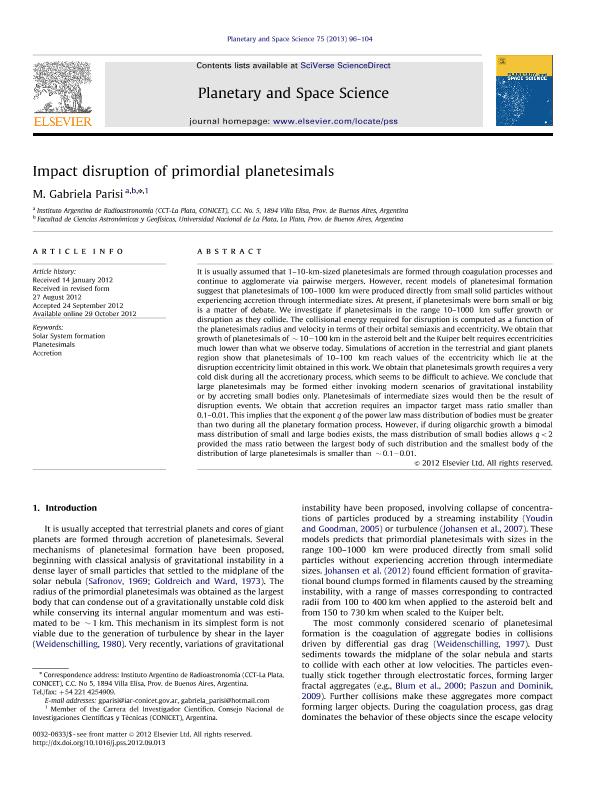Artículo
Impact disruption of primordial planetesimals
Fecha de publicación:
01/2013
Editorial:
Pergamon-elsevier Science Ltd
Revista:
Planetary And Space Science
ISSN:
0032-0633
Idioma:
Inglés
Tipo de recurso:
Artículo publicado
Clasificación temática:
Resumen
It isusually assumed that 1-10-km sized planetesimals are formed through coagulation processes and continue to agglomerate via pairwise mergers. However, recent models of planetesimal formation suggest that planetesimals of 100-1000km were produced directly from small solid particles without experiencing accretion through intermediate sizes. At present, if planetesimals were born small or big<br />is a matter of debate. We investigate if planetesimals in the range10-1000 km suffer growth or disruption as they collide.The collisional energy required for disruption is computed as a function of the planetesimals radius and velocity in terms of their orbital semiaxis and eccentricity. We obtain that growth of planetesimals of 10 -100 km in the asteroid belt and the Kuiper belt requires eccentricities much lower than what we observe today. Simulations of accretion in the terrestrial and giant planets region show that planetesimals of 10-100 km reach values of the eccentricity which lie at the disruption eccentricity limit obtained in this work. We obtain that planetesimals growth requires a very cold disk during all the accretionary process, which seems to be difficult to achieve. We conclude that large planetesimals may be formed either invoking modern scenarios of gravitational instability or by accreting small bodies only. Planetesimals of intermediate sizes would then be the result of disruption events. We obtain that accretion requires an impactor target mass ratio smaller than 0.1-0.01. This implies that the exponent q of the power law mass distribution of bodies must be greater than two during all the planetary formation process. However, if during oligarchic growth a bimodal mass distribution of small and large bodies exists, the mass distribution of small bodies allows q less than 2 provided the mass ratio between the largest body of such distribution and the smallest body of the distribution of large planetesimals is smaller than 0.1-0.01.
Palabras clave:
Solar System Formation
,
Planetesimals
,
Accretion
Archivos asociados
Licencia
Identificadores
Colecciones
Articulos(IAR)
Articulos de INST.ARG.DE RADIOASTRONOMIA (I)
Articulos de INST.ARG.DE RADIOASTRONOMIA (I)
Citación
Parisi, Mirta Gabriela; Impact disruption of primordial planetesimals; Pergamon-elsevier Science Ltd; Planetary And Space Science; 75; 1-2013; 96-104
Compartir
Altmétricas




